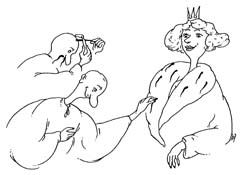A monument to Ukrainian serfdom
Catherine II as a mirror of Ukrainian statehood
Frankly speaking, the event I am going to describe is one of those that demonstrate the true solidity, value, and strength of Ukrainian independence and Ukrainian statehood per se. On Oct. 27 Odesa witnessed the long-advertised ceremony of unveiling the so-called Monument to the Founders of the City, with a statue of Catherine II of Russia in the center (the ceremony had been repeatedly postponed due to the resistance of the local patriotically minded community). Incidentally, a number of historians are correctly refuting her status as a city founder. Quite a few residents of Odesa regard the whole project as a Ukrainophobic one, aimed at inciting interethnic animosity, accompanied by clashes between protesters and Berkut riot squads, the latter apparently acting under orders from the municipal authorities to guard this monument to the Russia’s ruling bloodthirsty she- wolf (in the words of Taras Shevchenko) who ordered destruction of the Zaporozhian Sich and turned the Ukrainian peasants into serfs.
One can spend a long time pondering the issue of the “consolidating” effects of such projects — as is practiced by Party of Regions functionaries who are saying, “Let ‘em build a monument to Stepan Bandera in Lviv and Catherine II in Odesa, for we have a democracy, don’t we?” The Day asked its experts these questions: “How could such a project become a reality in Ukraine, in its 17th year of national independence, and what do you think it really means? Who is to assume political responsibility for the events that have taken place in conjunction with the unveiling of this monument?”
Prof. Yurii SHAPOVAL, Ph.D. (History):
Russians first asserted their position in Khadjibey, shortly to be renamed Odesa, “to the accompaniment of the Zaporozhian hopak dance.” I am not quoting from Oleh Tiahnybok, whom some persist in advertising as the number one expert on the “right kind” of Ukrainian history, but from Major General Jose de Ribas [known in Russia as Osip Mikhailovich Deribas]. The monument unveiled in Odesa is dedicated to a German woman by the name of Sophie Friederike Auguste, Prinzessin (princess) von Anhalt-Zerbst, destined to become Russia’s empress Catherine II.
This brings me back to [Russia’s Generalissimo] Count Aleksandr Suvorov, who helped transform the small Khadjibey fortress into a big port city, yet this process involved Ukrainian Cossacks. On July 4, 1794, Suvorov wrote in a special report addressed to Field Marshal Peter Rumyantsev-Zadunaisky that it would be worth enlisting the experience and skills of Cossacks that had not fled to the Kuban area in order to put together a local team of sailors. Twelve Cossack chaika boats constituted the bulk of the Odessa flotilla. The Russian military leader, who was at the time staying in the Polish town of Nemirow [today: Nemyriv in Ukraine] dispatched 76 Cossacks to Odesa (all of them members of his headquarters’ security detail). All told, there were more than 600 Ukrainian Cossacks among some one thousand first settlers in Odesa. And now we have a monument to Catherine II in Odesa.
Here one finds not only inadequate historical knowledge, but also an irresponsible attitude on the part of those who seem to have forgotten that they are living in an independent Ukrainian nation- state. The esteemed ranking bureaucrats of Odesa apparently don’t know enough about Catherine II, so why didn’t they ask experts at the National Academy’s Institute of History of Ukraine? They could have made inquiries at the history faculty of Odesa University. Why haven’t they asked for expert opinions before unleashing a war of monuments, let alone a war against monuments.
Another trouble is that over all these years, after Aug. 24, 1991, no one has been punished — even formally — for authorizing the construction of anti-Ukrainian monuments in this country. Hence the unveiling of a monument to a German woman in Odesa, who hated Ukraine, regarding it as a source of freethinking and a threat to her cherished alles ist in Ordnung system in the Russian empire.
Newspaper output №:
№32, (2007)Section
Day After Day





